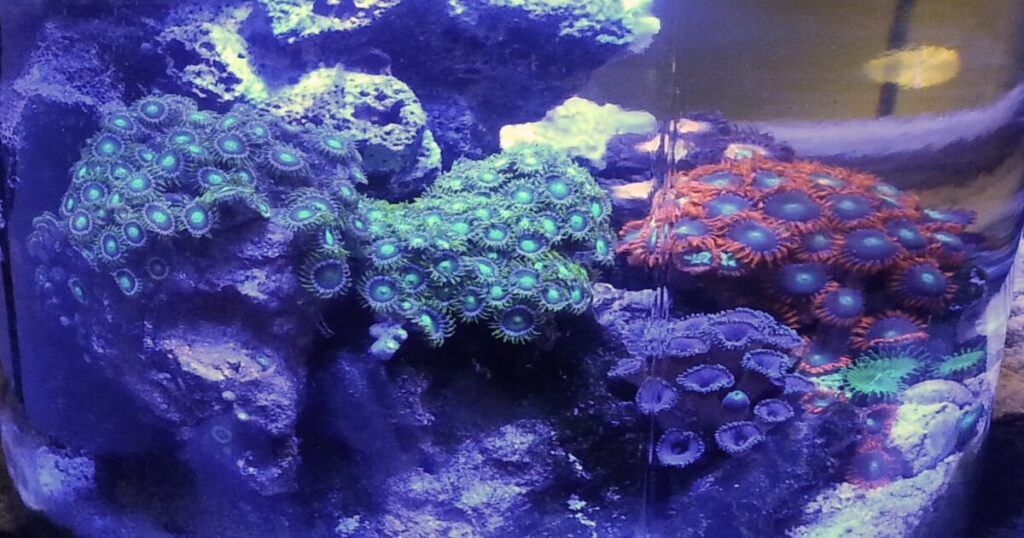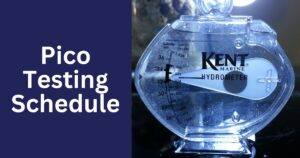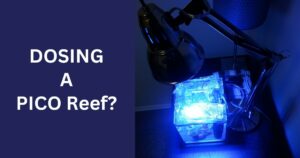The temperature in your pico reef isn’t just about avoiding the chills or dodging a heatwave. It’s about providing a stable environment where your corals and critters can thrive.
Unfortunately, the smaller water volume means temperatures can swing more dramatically than in larger tanks, which can stress or even kill your aquatic inhabitants.
So, here are my best tips for keeping your pico reef tank’s temperature consistent.
Adjusting Temperature In Your Pico Reef
So, you’ve been monitoring your pico reef like a hawk and notice the temperature’s veered off course. No sweat! The key here is to make changes gradually to avoid shocking your tank.
If The Temperature Is Too High
- Turn Off Excess Equipment: Start by turning off any non-essential equipment that generates heat, such as extra lights or pumps.
- Increase Aeration: Boosting aeration can help cool down your tank by increasing water movement and surface agitation, which promotes heat loss.
- Use Fans: Set up an aquarium fan (or even a small household fan) to blow across the water surface and your entire tank. This evaporative cooling can significantly lower the temperature over time.
- Ice It—But Smartly: If you’re in a pinch, floating a bag of ice or using frozen water bottles can offer quick relief. Just make sure they’re sealed well and introduced slowly to prevent drastic drops.
If the Temperature Is Too Low
- Check Your Heater: First things first, check that your heater is functioning correctly and is set to the right temperature.
- Reduce Tank Exposure: Minimize how much cold air hits your tank by moving it away from windows or drafts and covering it with a lid to retain heat (you should already be using a lid for a pico for evaporation purposes).
- Gradually Increase Heat: If everything looks fine, gradually turn up the heater and monitor it closely to avoid overheating.
Whether you’re heating up or cooling down, remember: slow and steady wins the race.
- Aim for Gradual Changes: Try not to change the temperature more than 2°F per hour. Even that might be pushing it for more sensitive species.
- Monitor Closely: Keep an eye on your thermometer throughout this process. Frequent checks will help you gauge how quickly the temperature is adjusting and when you’ve hit that ideal range.
- Watch Your Inhabitants: Pay attention to how your fish, corals, and invertebrates are reacting during these adjustments. Signs of stress could indicate that changes are happening too rapidly.
The Ideal Temperature Range

For most saltwater creatures, the ideal range in temperature falls between 76°F and 82°F (24-28°C). Staying within this range is the backbone of fostering a vibrant, healthy reef.
Temperature plays a massive role in the well-being of your coral, fish, and invertebrates for several reasons:
- Coral Health: Corals are not just colorful rocks. They’re living organisms that rely on a stable environment to support their internal processes, including photosynthesis and calcification (that’s how they grow). When the water is too cold or hot, corals become stressed, which can lead to bleaching – that’s when they expel the algae inside them and turn white (effectively killing them).
- Fish Well-being: I’m not a fan of fish in a pico, but if the water’s too warm or too cool for their liking, it can affect their immune system, making them more susceptible to diseases. Plus, extreme temperatures can mess with their metabolism and breeding behavior. You won’t see happy fish darting around if they’re not feeling their best.
- Invertebrate Comfort: Invertebrates such as snails, shrimp, and crabs are often the heroes of clean-up crews in many tanks. They’re pretty sensitive to sudden changes in temperature. Too hot or too cold can mean trouble for these little guys, affecting their ability to move around and do their job effectively.
Equipment For Temperature Control
Getting a grip on temperature control in your pico reef isn’t just about crossing your fingers and hoping for the best. It starts by equipping yourself with the right tools for the job.
Thermometers
Keeping tabs on your pico reef’s temperature requires reliable thermometers. Here’s a quick guide to help you choose between glass and digital options:
- Glass Thermometers: These are budget-friendly but need more tank space and can be harder to read depending on tank placement.
- Digital Thermometers: These offer precise temperature readings with easy-to-read displays. Many models come with external probes that can be placed inside the tank while keeping the display outside, minimizing intrusion into your reef’s aesthetic.
Your choice should balance budget, space, and ease of reading to ensure your pico reef remains at the optimal temperature.
Heaters
Not all heaters are created equal, especially when we’re talking about pico reefs. Here are a few tips for picking the perfect heater:
- Size Matters: For pico reefs, compact is key. Look for mini or nano heaters that won’t take up too much space.
- Wattage Wisdom: Generally, you’ll want around 3-5 watts per gallon of water. However, consider your room’s average temperature; if it tends to be cooler, you might need a bit more power. I used a 25w heater for my 1-gallon Cookie Jar reef, and it has been more than enough even in winter months.
- Adjustability is Awesome: An adjustable heater allows you to fine-tune the temperature to match your tank’s specific needs.
Challenges In Temperature Regulation
Keeping the temperature right in a pico reef can feel like walking a tightrope. You’re constantly balancing, making tiny adjustments to avoid a tumble.
The small volume of water in these tanks makes them particularly sensitive to changes from within and outside the tank.
Let’s break down some of the common hurdles you might face:
First off, there’s the issue of room temperature. Unlike larger tanks, pico reefs can’t buffer against fluctuations in the ambient temperature of the room they’re in.
If it’s a hot summer day and your AC decides to take a vacation, your tank’s temperature could spike dangerously high. Conversely, if you’re saving on heating during a cold snap, your little reef can die off within a few short hours.
Then there’s lighting. Aquarium lights do more than just showcase the beauty of your tank and give corals the light they need. They also emit heat. While LED lights are cooler than traditional options, they can still warm up your water, especially when set close.
And if you’re rocking an older model or something more intense for coral growth, that heat output becomes even more significant.
To navigate these challenges successfully, consider these strategies:
- Location Is Key: Positioning your tank away from direct sunlight and drafts can help minimize sudden changes due to room temperature fluctuations.
- Choose Lighting Wisely: Opt for LED lights designed specifically for aquariums, which offer brightness without as much heat output.
- Monitor Regularly: Keep a close watch on your tank’s temperature throughout the day. A digital thermometer with alerts can be your best friend here.
Keeping the temperature in check within your pico reef is not just about hitting the right numbers. It’s about ensuring the well-being and comfort of your tank’s inhabitants, making it not just a visual delight but a thriving community.





